Passive, nice "additions" to strong, brave and endowed with absolute power kings? Not at all! Medieval rulers did not give a damn and when they could, they marked their presence in a world dominated by men. And not only them ...
Despite discrimination against women in Germanic law, they nevertheless played a role in public affairs of the early Middle Ages. In the turbulent and violent life of the Frankish state, described by Gregory - Bishop of Tours - in the 6th century, where women had few rights, but numerous prohibitions, the queens made their presence felt.
Scandalists and schemers
Among the queens who were surprisingly successful in expressing their personality and aspirations was Radegund, princess of Thuringia and one of the seven wives of King Chlotar. Kidnapped in childhood and forced into marriage at the age of twelve, Radegund irritated the king with her passive resistance.
Chlotar complained that she was acting more like a nun than a monarch, devoting herself to charity, making him wait for himself at mealtimes, leaving his bedside to pray, and wearing a hair shirt under royal robes.
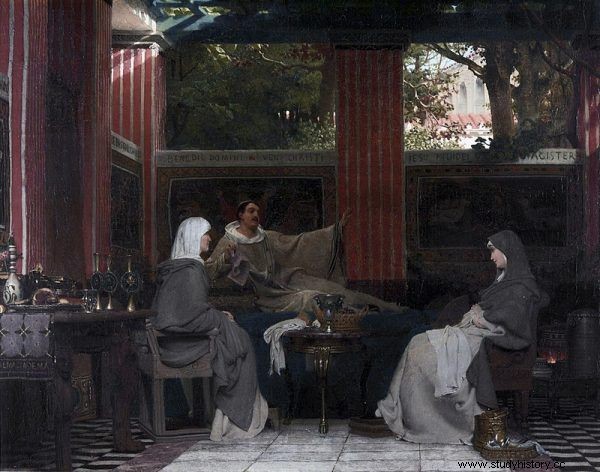
Radegunda (in the picture listens to the recitation of poems) ran away from her husband to a convent - and spent the rest of her life there.
When Chlotar murdered her younger brother - Gregory did not note why - Radegunda fled to Noyon and devoted herself zealously to the religious service. Angry, Chlotar chased her, but Bishop Medard intervened and finally persuaded the king to found the Convent of the Holy Cross in Poitiers, where the queen had already stayed (...).
Two other ladies, the wives of Clovis' grandsons, became the heroines of bloodier chapters in Gregory's gloomy chronicles. Under the influence of the intrigues of Fredegunda, the modestly born servant of Queen Audowera and the wife of King Chilperic, the latter renounced her lawful wife and sent her to a convent where she was killed, on the orders of Fredegund.
After that, Fredegunda married the king himself, the first step in her violent career, during which she led to the murder of Chilperic's third wife, the Visigothic Princess Galswinta, as well as the murder of many of her political enemies, including Chilperic's brother Sigebert, the murder of Chilperic's sons, made by other wives and concubines; Fredegund also ordered to torture and poison selected people.
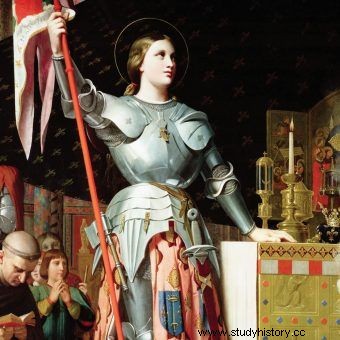
Joanna d'Arc (pictured) became the head of the army in the 15th century. But she was not the first woman to "take matters into her own hands." Already in the early Middle Ages, ladies made their presence felt in history.
Her rival Brunhilda, Sigebert's wife and the sister of the murdered Galswinta, was equally terrifying, though perhaps a little less perfidious. As regent, and later queen mother, she fought against Fredegunda, the mighty Franks, and finally her nephew, Chlotar II, but was eventually captured and executed after being tortured.
The art of survival in the male world
Amalasunta, the daughter of the Ostrogothic king Theodoric the Great, who ruled in Italy, ruled as regent on behalf of her ten-year-old son after her father's death in 526. This educated woman (...) came into conflict with the Ostrogothic nobles due to the fact that it pursued a probizantine policy. She was overthrown and exiled by her cousin Theodahad, who supported the Goths. She died strangled in a bath by the Ostrogothic notables.
Italy had its Fredegunda in the person of Marosia, who ruled Rome with her father and mother for several decades at the beginning of the 10th century. Marosia led to the imprisonment of Pope John X (allegedly her mother's lover before), who died shortly thereafter - most likely murdered - and replaced him with John XI, who was rumored to be her son with Pope Sergius III.
The twice widowed Marosia then married the King of Italy, Hugh of Arles, but Alberyk, her son from his first marriage, expelled his mother and stepfather in Castel Sant'Angelo, exiled Hugh to end Marosia's rule.
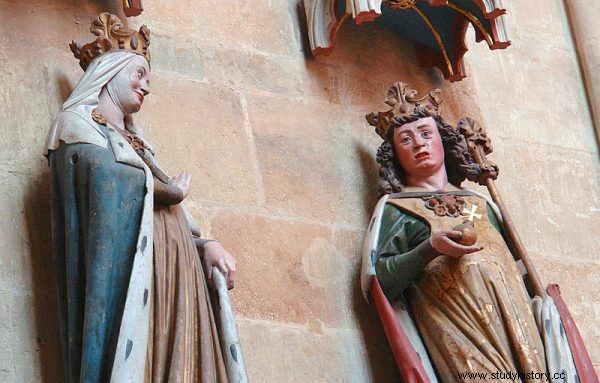
Adelaide with her second husband - Otto I.
In the 10th century, at least one talented monarch played a significant role in politics in Germany:Empress Adelaide of Burgundy, wife of Otto the Great. After Otto's death, Adelaide's son, Otto II, made her the viceroy of Italy. When he died, Adelaide successfully fought for power with her three-year-old grandson Otto III. For eight years, she ruled on behalf of this child with his mother, Teofano.
After Theophano's death in 991, took over on her own and ruled the empire for three years until Otton became an adult; then she stepped back into the shadows and went into charity, and was eventually considered a saint.
At home and on the battlefield
In the early Middle Ages, women sometimes even commanded troops. In England, Ethelflæd, daughter of King Alfred the Great, led warriors against the Vikings, built fortresses on the borders of Mercia, and undertook the repair of fortifications built by the Romans.
(...) Until her death in 918, Ethelflæd conquered East England and the northern areas as far as the Welland River (north of Norfolk), making her brother Edward the Elder the most powerful ruler of England at that time.
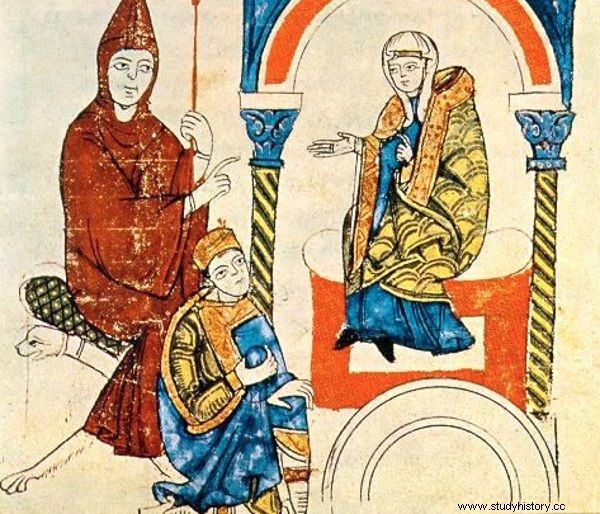
Tuscan Matilda with Abbot Hugo of Cluny and Emperor Henry IV.
Century and a half later Matylda, Margrave of Tuscany, la gran contessa heiress of the vast lands that stretched from the northern slopes of the Apennines to the foothills of the Alps, she sometimes wore a helmet and chain mail to support the popes in their struggle against the German emperors. Matilda's participation in the conflict between Pope Gregory VII and Emperor Henry IV made her castle in Canossa famous, where the emperor went in penitential hairdresser in January 1077.
Sikelgaita, the Lombard duchess who married the famous Norman chief Robert Guiscard, was a veritable Valkyrie - tall, strong, muscular. She usually accompanied her husband in battles , and the Byzantine historian Anna Comnena wrote that "the sight of this woman in full armor was terrifying." When the Normans were forced by the Byzantines to retreat at the Battle of Durazzo, according to Anna Comnena,
Robert's own wife (who was riding by his side like a second Pallas, if not Athena) saw the soldiers scattering, glared at them and called to them in her own loud voice. language like Homer:«Where are you going to run? Stand up to fight and die as befits husbands! ». And when she saw that they were still fleeing, she grabbed a long spear and galloped after the fleeing people, who, seeing this, came to their senses and resumed the fight.
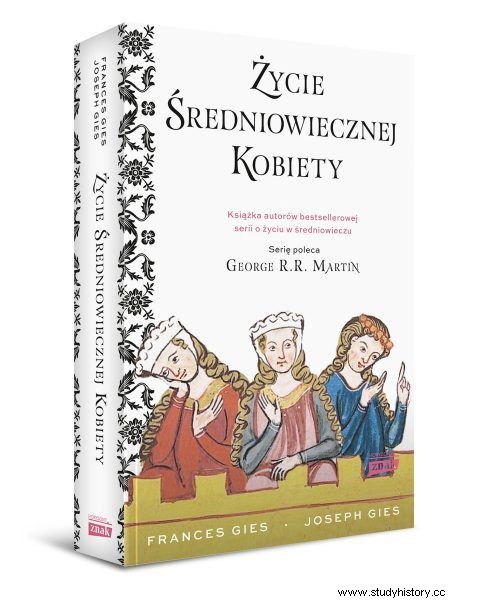
The text is based on the latest volume of the best-selling series by Francis and Joseph Gies "The Life of a Medieval Woman" , which was released by the Znak Horyzont publishing house.
(…) Most of what is known about women of the early Middle Ages concerns representatives of the ruling classes. However, a recent scholarly dissertation by historian David Herlihy, which examines ancient documents relating to trade and lease from 700 to 1200 AD, provides valuable insight into the role played by women from other classes in society. (…) Professor Herlihy concludes:The great, distant, dramatic events of those days, wars and crusades were the work of active men. But these feats matched, and perhaps made them possible at all, the efforts of equally active women. The achievements of both must be treated inseparably as a kind of collective achievement that is fascinating in itself and has had a profound impact on the traditions of the West.
Source:
The above text is an excerpt from the book by Frances and Joseph Gies "The Life of a Medieval Woman" , published by the Znak Horyzont publishing house.
The title, lead, illustrations with captions, bolds and subtitles come from the editorial office. The text has undergone some basic editing to introduce more frequent paragraph breaks.
Find out what life was like for women in the dark ages of history:
